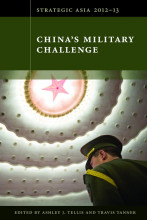Summary: Strategic Asia 2012-13: China's Military Challenge | 9780981890432 | Ashley J Tellis, et al
- This + 400k other summaries
- A unique study and practice tool
- Never study anything twice again
- Get the grades you hope for
- 100% sure, 100% understanding
Read the summary and the most important questions on Strategic Asia 2012-13: China's Military Challenge | 9780981890432 | Ashley J. Tellis; Dan Blumenthal
-
0 Uphill Challenges: China's Military Modernization and Asian Security
This is a preview. There are 2 more flashcards available for chapter 0
Show more cards here -
Why the presence of the US was difficult to challenge in the Asian sea for USSR?
-US was really strong military and technologically in advance
-Core of Soviet power in the European part
-Air and land communication roads long tenuous and relatively undevelopped: sustainibility of the Red Army there was challenging
-Soviet combat power less significant in this area than in Europe -
What is the US legacy in Asia?
- More stability
- The birth of a new economic order -
How did the super military American power ensure stability in the region?
-Prevent one country from attempting hegemonic domination on the region. From preventing that and that one country may have access at all the main ressources of the region, the US was also ensuring itself to remain the most significant world power
- Dampen local security competition between regional states.
- Creation of a new liberal international economic order. By focusing more on economic development and reconstruction than on security issues (safety ensured by the US), countries developed and rised as regional economic power. Helped to fight communism pressures -
What were the structural conditions that permitted the creation and maintenancce of this new liberal international oreder?
- economic hegemony of the US globally, amplified by the use of the dollar as the international reserve currency
- political willingness within the US to bear the costs of global leadership
-military superiority
-no Asian powers as a rival -
Apart from the military part, what are the challenges that have developed for the US in the wake of China's economic success?
-Diminish the US economic leadership. Deindustrialization (big concern for blue collars); technology competition; US starting dependence on China (debtor)
-Geopolitical concerns. Integration of the region diminish the US influence on its allies and neutral states which tend to be more sensitive to China's interests because it is center of the highly integrated Asian market -
What is A2/AD and what is its main goal?
It refers to Chinese military policy in anti-access/area-denial capabilities.
It aims at keeping the US entrirely out of China's "near seas" by controlling access to their farther approaches through a variety of stand-off attacks. -
What are the purposes of such a modenization? What is the bigger picture?
- Main goal in territorial security and integrity
- But Hu Jintao claimed in 2004 that the PLA had "new historic missions": protection of CCP, safeguarding China's expanding national interests and contribution to the preservation of world peace
-Whether its scope is bigger than the Asian region does not really matter because Asia remains today the material core of the evolving international order. Therefore, any Chinese hegemony over even this delimited space would decisively advantage it in any future struggle for control of the global system. -
Who uses the metaphor of "holding the ring" to describe the situation in Asia, and what does it mean? Is it still relevant?
- Jonathan Pollack.
- The metaphor describes a situation where none of the major Asian powers had the capicity to seriously harm their rivals or prevent the US from being able to come to an ally's aid, while the US lacks thei ncentives to use its power abusively.
- This stability is on the edge because of China's ongoing military improvements -
When was the Taiwan Strait crisis
1995-96 -
1 China's Land Forces: New Priorities and Capabilities
This is a preview. There are 5 more flashcards available for chapter 1
Show more cards here -
When the PRC was created in 1949, what was seen as its central task? How did this affect national psychology?
After the "century of humiliation", PRC first goal was to ensure China's national security. The PLA and the CCP were therefore as one, sharing the objective to consolidate and defend what then constituted China. In the process, national defense became intertwined with national psychology
- Higher grades + faster learning
- Never study anything twice
- 100% sure, 100% understanding
































